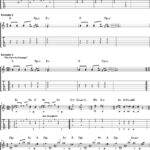Guitar chords can sometimes feel like a secret language, especially when you encounter terms like “F2”. If you’ve stumbled upon the “Guitar F2 Chord” and are scratching your head wondering what it is, you’re not alone. This seemingly simple chord name can actually lead to confusion. Let’s clarify what guitarists usually mean when they talk about an “F2 chord” and explore the more accurate ways to name this chord.
Unpacking the “F2” Chord: What Does It Really Mean?
The term “F2” isn’t officially recognized in standard music theory. When guitarists or musicians use “F2”, they are generally referring to one of two chords: Fadd2 or Fsus2. The number “2” in chord nomenclature indicates the inclusion of the second degree of the major scale. In the key of F major (F-G-A-Bb-C-D-E), the 2nd degree is G.
The ambiguity arises because “F2” doesn’t clearly specify how this 2nd degree (G) is added to the F chord. Is it added as an “added” note, or is it replacing another note in the basic F triad? This distinction is crucial because it leads to two very different chords: Fadd2 and Fsus2.
Fadd2 Chord: Adding Flavor to the F Major
The Fadd2 chord (F added 2) is an F major triad with the 2nd degree of the major scale added. An F major triad consists of the root (F), the major third (A), and the perfect fifth (C). When we “add2”, we are adding the 2nd degree (G) in addition to these notes.
Therefore, the notes in an Fadd2 chord are:
- Root: F
- Major Third: A
- Perfect Fifth: C
- Added Second: G
The Fadd2 chord has a bright, open, and slightly folksy sound. It’s a pleasant variation of the F major chord, adding a touch of sweetness without altering the major quality.
Fsus2 Chord: Suspending the Third for a Unique Sound
On the other hand, the Fsus2 chord (F suspended 2) is also built with the 2nd degree, but in a different way. The term “sus” (suspended) indicates that the major or minor third of the triad is replaced by another interval, in this case, the 2nd degree.
So, in an Fsus2 chord, the major third (A) of the F major triad is suspended and replaced by the 2nd degree (G). The notes in an Fsus2 chord are:
- Root: F
- Second (Suspended): G
- Perfect Fifth: C
Notice that the Fsus2 chord does not contain the major third (A). This absence of the third is what gives sus chords their characteristic “suspended” or unresolved sound. Fsus2 chords are often described as airy, open, and less harmonically defined than major or minor chords.
Why “F2” is Problematic: The Case for Clarity
While some guitarists might use “F2” as shorthand, it’s essential to understand why it’s not ideal, especially in written music or when communicating with other musicians. The main issue is the ambiguity. “F2” could be interpreted as either Fadd2 or Fsus2, leading to potential confusion and incorrect playing.
Music theory conventions generally use “add” to indicate an added note without removing any notes from the basic triad. “Sus” is used to indicate the replacement of the third. Therefore, to be precise and avoid ambiguity:
- Use Fadd2 when you mean an F major chord with an added 2nd degree.
- Use Fsus2 when you mean an F chord with the third replaced by the 2nd degree.
An example of a guitar chord diagram. While this diagram shows Fadd9, similar diagrams exist for Fadd2 and Fsus2, visually representing finger placements on the fretboard.
Best Practices: Be Clear in Your Chord Naming
In conclusion, while you might encounter “F2” in informal contexts, it’s best to avoid using this ambiguous term. When writing chord charts, discussing music, or teaching guitar, always strive for clarity.
- Prefer Fadd2 or Fsus2 over “F2” to eliminate ambiguity.
- Context matters: If you see “F2”, try to understand the musical context to infer whether it’s likely intended to be Fadd2 or Fsus2. However, it’s always better to ask for clarification.
By using precise chord names like Fadd2 and Fsus2, you ensure clear communication and avoid any musical misunderstandings. Understanding the difference between these chords not only enhances your theoretical knowledge but also expands your sonic palette on the guitar.


